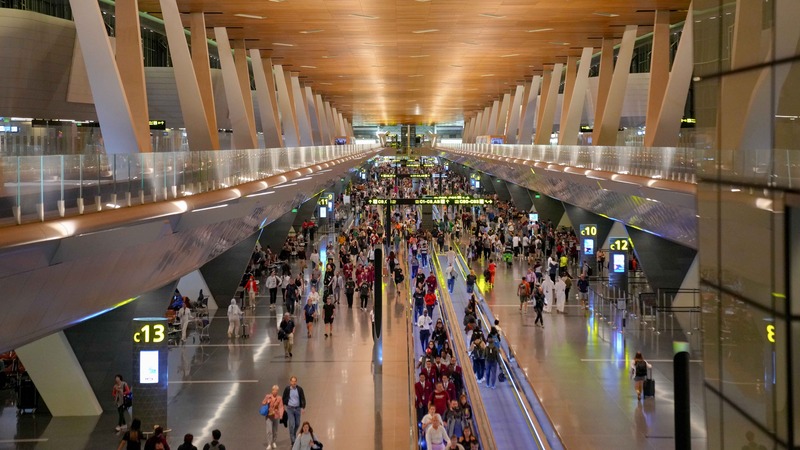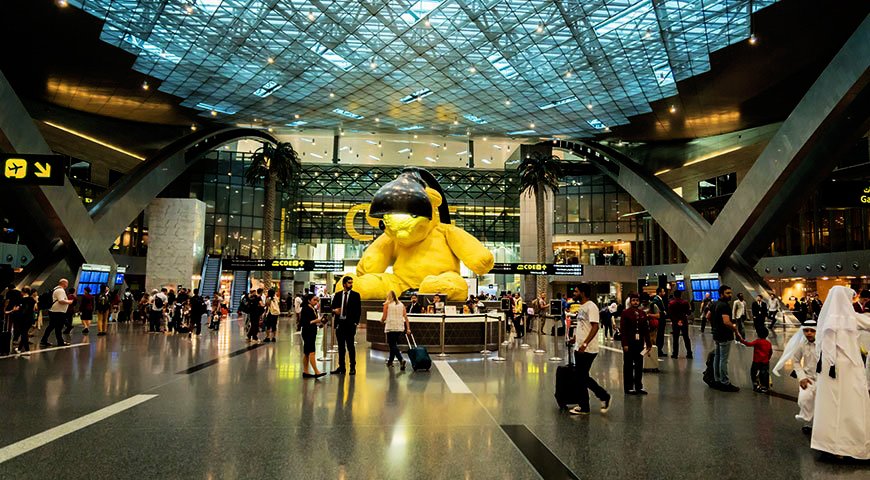
Renowned as one of the world’s premier airports, Hamad International Airport (HIA) is a vibrant hub bursting with activities for travelers during layovers. Opened in 2014, HIA has quickly established itself as a leading global gateway, connecting passengers to over 160 destinations worldwide. Recognized in the 2024 Skytrax World Airport Awards as the "World’s Best Airport," it has also claimed the title of "Best Airport in the Middle East" for ten consecutive years.

HIA is not just an airport; it’s a destination in itself, featuring state-of-the-art design, luxurious amenities, and a commitment to passenger comfort. With its spacious terminals, cutting-edge technology, and exceptional customer service, the airport offers an unparalleled experience. Whether you’re traveling from the Indian subcontinent to Europe, Africa, or the United States, your layover at HIA can be both enjoyable and productive.

As you explore the airport, you’ll discover a wealth of attractions, from art installations and wellness centers to gourmet dining options and shopping galore. Here’s a closer look at what you can do during your layover at this remarkable airport.
Get Moving at the Vitality Centre
For fitness enthusiasts, the Vitality Wellbeing and Fitness Centre is a must-visit. Located on the fourth floor of the Oryx Airport Hotel, this award-winning facility features a fully equipped gym, a stunning 25-meter swimming pool with panoramic views of the runway, a premium golf simulator, and squash courts.

The center also offers yoga classes and personal training sessions, making it easy to stay active during your layover. Open daily from 6 AM to 2 AM, it’s the perfect spot to energize before your next flight!
Art and Culture Await
Art lovers will be captivated by the airport’s impressive collection of installations. Marvel at the whimsical "Lamp Bear" by Swiss artist Urs Fischer, a 20-foot sculpture that delights visitors of all ages.

Another highlight is the "Wildlife Wonderscapes" installation by artists Gillie and Marc Schattner, which features life-sized sculptures of endangered animals, prompting reflection on conservation efforts. With approximately 30 art pieces scattered throughout the terminal, HIA transforms waiting time into a cultural journey that showcases both local and international talent.
Find Tranquility at The Orchard
Step into The Orchard, a lush indoor garden that provides a peaceful sanctuary for weary travelers. Spanning 6,000 square meters, this serene space boasts over 300 trees and 25,000 plants, creating a tropical atmosphere. The innovative design utilizes a stunning 85-meter grid shell roof, allowing natural light to flood the area while regulating temperature for comfort.

As part of the LEED Gold-certified Central Concourse, The Orchard emphasizes sustainability and passenger well-being, making it a perfect spot to unwind.
Luxurious Lounges for Work and Relaxation
HIA offers several world-class lounges, including the exclusive Al Mourjan Lounge, which features a serene garden, spa facilities, and a restaurant serving gourmet meals. Other options like the Al Safwa First Lounge for Qatar Airways first-class passengers provide private sleeping rooms and showers.

The Muzn Lounge caters to families and children with special needs, featuring a sensory room designed for relaxation. Day passes are available for most lounges, allowing travelers to enjoy luxurious amenities and high-speed Wi-Fi to stay productive during their layover.
Indulge in Wellness Treatments
Pamper yourself at the Vitality Wellbeing and Fitness Centre with an array of rejuvenating treatments. Choose from soothing massages, invigorating aromatherapy sessions, and beauty treatments that include manicures and pedicures.

Hydrotherapy and hot stone treatments are also available, ensuring you feel refreshed and revitalized before your next adventure. Booking treatments in advance is advisable, especially during peak travel times.
Shop 'Til You Drop
With over 50 retail outlets, shopping at HIA is a delightful experience. Explore high-end brands like Burberry, Rolex, and Gucci, or find unique local souvenirs at Souq Al Matar, which recreates a traditional Qatari souq experience.

This vibrant area features shops selling traditional clothing, handicrafts, and Qatari delicacies. Don't miss out on duty-free deals, as many shops offer exclusive products that are available only at the airport, making it a great opportunity to stock up on gifts and luxury items.
Savor Culinary Delights
Dining options at HIA are virtually limitless! Sip expertly brewed coffee at Fendi Café, enjoy high tea at the elegant Harrods' Tea Room, or indulge in a meal at Gordon Ramsay’s Burger and Street Pizza. For a truly unique experience, dine at the Louis Vuitton Lounge, where chef Yannick Alléno creates exquisite dishes.

Many restaurants also offer takeout options, so you can enjoy a meal on the go. Be sure to try local Qatari specialties, such as Machboos and Harees, available at various dining venues.
Rest Easy
Feeling fatigued? The sleep’n fly lounge offers comfortable accommodations on a pay-by-the-hour basis, with options ranging from cozy sleep pods to family cabins designed for multiple occupants.

Additionally, numerous quiet rooms throughout the airport provide a serene atmosphere for resting or catching up on reading. Travelers can also take advantage of the 24-hour baggage storage service, allowing you to explore the airport unencumbered.
Transportation and Connectivity
Hamad International Airport is well-connected to the city and surrounding areas. If you have a longer layover, consider taking a short trip into Doha. The airport offers convenient transportation options, including taxis, ride-sharing services, and public transport.

The Doha Metro provides an efficient way to access the city, with a dedicated station at the airport. If time allows, visit the Museum of Islamic Art or explore the Souq Waqif, a bustling market where you can experience traditional Qatari culture.

Additional Tips for Travelers
- Check Visa Requirements: If you plan to leave the airport during your layover, ensure you check visa requirements for Qatar. Many nationalities can obtain a transit visa on arrival.
- Stay Hydrated: Airports can be dehydrating environments. Drink plenty of water during your layover, and consider carrying a refillable water bottle.
- Plan Your Time: Make sure to keep an eye on your flight schedule. Allow ample time to return to your gate, especially if you plan to explore outside the airport.
- Use the Airport App: Download the HIA mobile app for real-time flight updates, maps of the airport, and information on shops and dining options.
- Explore Family Facilities: If you’re traveling with children, take advantage of the family rooms and play areas, which provide a fun and safe environment for kids.
- Enjoy Free Activities: Some lounges and areas offer complimentary activities, such as movie screenings or art workshops—check schedules to participate.
- Be Mindful of Cultural Norms: Qatar has a rich cultural heritage. Dress modestly and respect local customs, especially in dining areas and public spaces.
- Currency Exchange: If you need cash, currency exchange counters and ATMs are readily available throughout the airport. Credit cards are widely accepted, but having some local currency can be beneficial.
- Relaxation Areas: Take advantage of the numerous relaxation zones throughout the airport, where you can unwind on comfortable seating.
- Emergency Contacts: Familiarize yourself with emergency contacts and medical assistance available at the airport, just in case.
.jpg)
In summary, Hamad International Airport is more than just a transit point; it’s a destination filled with engaging activities, luxurious amenities, and practical services. Make the most of your layover at HIA and experience all it has to offer!





.jpg)

 – 14,763 feet (1).jpg)






.png)






.jpg)


.jpg)




.jpg)



.jpg)




.jpg)


.jpg)